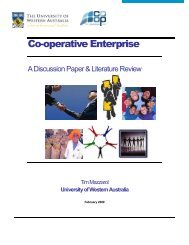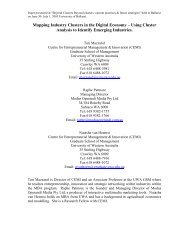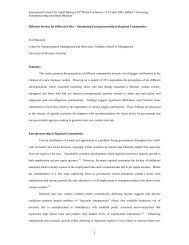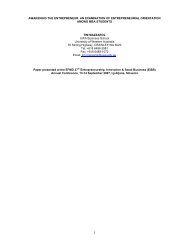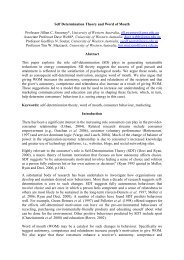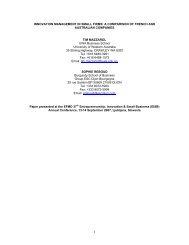The Future of Farming: Strategic Intent, Technology Diffusion ... - CEMI
The Future of Farming: Strategic Intent, Technology Diffusion ... - CEMI
The Future of Farming: Strategic Intent, Technology Diffusion ... - CEMI
Create successful ePaper yourself
Turn your PDF publications into a flip-book with our unique Google optimized e-Paper software.
Centre for Entrepreneurial Management and Innovation<strong>The</strong> <strong>Future</strong> <strong>of</strong> <strong>Farming</strong>: <strong>Strategic</strong> <strong>Intent</strong>, <strong>Technology</strong> <strong>Diffusion</strong> and Precision Farm Management9sensitive an enterprise is to both adverse environmental and market conditions, the greater the need foraccurate and timely management data across the whole farm. <strong>The</strong>refore the need for FOO-PGR technologies islikely to be greater for these enterprises.Producers whose enterprises were highly sensitive to environmental forces were more likely to respond byadopting innovative grazing practices across their whole enterprise to maximise pasture utilisation, whereasproducers with ‘slack’ in their pasture system would be slower to adopt these practices. This suggests thatproducers with enterprises structured to maximise pasture production will be more likely to adopt remotelysensed FOO-PGR technologies than those producers who are yet to realise the opportunities for increasedutilisation within their pasture system.With regards to strong strategic management capabilities, this study found that producers actively forwardplan yet three out <strong>of</strong> the four cases based plans upon intuition rather than robust management information.Strong strategic management capabilities are evident among the case study producers but formal planning israrely undertaken. This lack <strong>of</strong> formal planning may be caused by a lack <strong>of</strong> accurate and timely managementinformation, lack <strong>of</strong> time or lack <strong>of</strong> formal planning capabilities. <strong>The</strong>refore it is critical that remotely sensedFOO-PGR technologies be developed as both a tactical and strategic management tool, providing theinformation to plan feed budgets in advance and monitor progress with accurate and timely data.Peer group participation was found to be a key source <strong>of</strong> influence for the case study producers. This indicatesthat the developers <strong>of</strong> remotely sensed FOO-PGR technologies should look to producer groups for technologychampions, ongoing innovation development and an effective means <strong>of</strong> disseminating marketing messages.This study also found that relationships along the wool supply chain are perceived by producers to be poor andthat the lack <strong>of</strong> communication between purchasers and suppliers has prevented market demand informationregarding wool quality attributes from reaching producers. Poor supply-chain integration is impacting upon theproducer’s desire to grow quality fibre and is likely to impact upon the producer’s likelihood to adopt FOO andPGR technologies as a quality management tool.Finally, the utilisation <strong>of</strong> the FOO and PGR technologies is likely to be influenced by the overall strategic intent<strong>of</strong> the wool enterprise. As noted in the case study results, enterprise structure, strategic planning andapproach to the wool market reflect the underlying strategic intent <strong>of</strong> each enterprise, with the casesrepresented in this study reflecting either production or market oriented strategies. <strong>The</strong>se findings haveresulted in the following research propositions for further exploration:P 1:P 2:P 3:P 4:P 5:<strong>The</strong> propensity for wool producers to adopt remotely sensed FOO-PGR technologies is contingent uponthe structure <strong>of</strong> the enterprise.<strong>The</strong> propensity for wool producers to adopt remotely sensed FOO-PGR technologies will be contingentupon strong strategic management capabilities.<strong>The</strong> propensity <strong>of</strong> wool producers to adopt remotely sensed FOO-PGR data will be contingent upontheir participation in producer groups.<strong>The</strong> propensity <strong>of</strong> wool producers to adopt remotely sensed FOO-PGR data will be contingent upontheir access to market demand information.<strong>The</strong> propensity <strong>of</strong> wool producers to adopt remotely sensed FOO-PGR technologies will be contingentupon the attributes <strong>of</strong> the innovation.Centre for Entrepreneurial Management and Innovation | www.cemi.com.au



